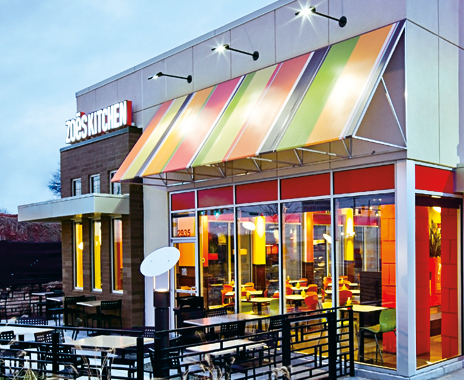When fast-casual chain Zoës Kitchen Inc. debuted on the New York Stock Exchange last April, the Plano, Texas–based Mediterranean-style eatery recorded its initial public offering at $87.5 million. Satisfying an investor appetite for investments within the trendy fast-casual space, Zoës’ strong showing out of the gate was the result of a well-executed strategy—as well as an indicator of fundamental financial shifts underway in the limited-service restaurant industry, experts say.
By the end of 2014, the fast-casual space had also seen an offering of around $100 million from Habit Restaurants LLC, which operates the build-your-own-burger concept Habit Burger. There was also an IPO from West Coast Mexican chicken chain El Pollo Loco, which was reported to have brought in $107 million after pricing 7.14 million shares. Rumblings around the industry suggested Wingstop was about to file an IPO of its own, while rumors proved true that Shake Shack would do the same; it filed for its offering in the last week of December.
The recent IPO activity is the light at the end of the tunnel after an ongoing slow period for restaurant offerings, industry professionals say. Fast-casual IPOs in particular keep driving upward, with the category well positioned to serve both consumers and investors. Experts say the sector will continue to grow on the back of consumer and investor demand.
For Kevin Miles, Zoës president and CEO, navigating an IPO required the coordination of multiple moving parts. As institutional and retail investors come on board, a whole slew of regulatory requirements come into play as the Securities and Exchange Commission (SEC) becomes a party to the business. All the while, Miles was responsible for fortifying Zoës so it could be a high performer in the stock market.
Exploratory discussions began in late 2012—around the time Miles took the helm of Zoës—but more definite movements toward going public didn’t begin for another year. The difference between exploring an IPO and officially moving toward one is full of incremental steps, he says.
“We’re running a marathon, not a sprint,” Miles says. “We’re very diligent in our growth. We also know to stay true to the culture of our brand.” He adds that, because new financial rules surrounding IPO disclosures allow exploratory-level discussions to remain confidential, more fast-casual dining executives will likely be interested in exploring the move.
But overseeing the company’s direction after filing for an IPO is no simple matter. A public company means executives must answer to both customers and investors, balancing a solid brand with steady growth. At Zoës, for example, plans are in place to grow to around 1,600 stores over the next few years, up from the 131 units it has open today in 15 states.
“Investors are interested in growth companies,” Miles says. The primary focus is to make “steady progress against the plan,” he says, in order to build long-term shareholder value. And while delivering on the numbers is central to the expectations of Miles’ job, “no one is asking us to get there tomorrow,” he adds.
At least part of the reason Zoës has experienced a relatively smooth transition as a public company is the Jumpstart Our Business Startups Act, also known as the JOBS Act of 2012, says attorney John Remakel, a partner at the Minneapolis firm Monroe Moxness Berg PA. The legislation eases various rules surrounding securities, such as the requirement to disclose the possibility of selling stock as a public company.
“They’re allowed to test the water now,” Remakel says, without fully committing to an IPO. Central to the legal end of the new rules is Form S-1, a Registration Statement filed with the SEC. Regulatory triggers were loosened as a way to spur private investment toward economic growth. The new rules mostly affect smaller companies, namely those with valuations of less than $1 billion, Remakel says.
The ability to quietly explore expansion possibilities has proved critical to incentivizing the public offering process. After a dearth of restaurant offerings over the last few years, insiders are forecasting a busy year in 2015.
As John Gordon, principal with Pacific Management Consulting Group in San Diego, sees it, the investing public’s appetite for restaurant stock—especially fast casual—is unquestioned. “New restaurant brands drive excitement,” Gordon says. It’s the new brands, he says, that have an edge in the marketplace.
But creating market buzz is a far cry from navigating a successful initial public offering. Where restaurants with an especially small footprint can survive and even thrive with the original founders or private equity, moving into the publicly traded space is a whole other ballgame. Because of this, Gordon says, founders rarely stay at the helm once the decision to go public is made. “Many times they have more creative skills than business skills,” he says.
As more limited-service brands choose to meet investment demand with IPOs, Gordon says, the temptation will be great for more smaller players to enter the market. But while selling shares carries strong appeal to parties on all sides of the deal, he says, going public too soon is worse than not going public at all.
He says an IPO needs to hover at least between $80–$100 million in order to be viable.
“Wall Street requires a bigger base, a bigger market,” Gordon says.












